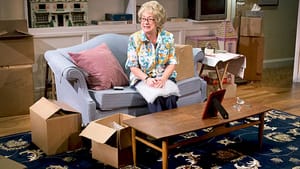Stay in the Loop
BSR publishes on a weekly schedule, with an email newsletter every Wednesday and Thursday morning. There’s no paywall, and subscribing is always free.
Healing the world with sex
'Becoming Dr. Ruth' at the Walnut Street Theatre

Celebrities are people we think we know. Sometimes we want to be like them, sometimes we judge them, but rarely do we get to know about the lives they lived before they became famous. This is a peek behind the curtain of one celebrity whose life was a drama all on its own.
“We can’t know who we are without knowing who we were,” says Dr. Ruth Westheimer, played by Jane Ridley in the Walnut Street Theatre production of Becoming Dr. Ruth. During the play, she tells us who she was and how she came to be the woman we know as “Dr. Ruth.” Ridley channels the diminutive sex therapist known for her almost constant smile and attitude of making the best of whatever comes her way. What came her way in her lifetime was more than many of us could deal with.
Set in an apartment (the scenic design is by Andrew Thompson) that Dr. Ruth shared with her recently deceased husband, Manfred Westheimer, whom she called Fred, the action consists of her packing up her belongings, telling the story of each item as it is carefully wrapped and put into a box. She shows us the turtles she collected as a reminder to stick her neck out, the pictures of her parents lost in the Holocaust, and the six dollhouses that allowed her to create the happy childhood she never had.
Anchors for her memories
She has kept journals of her story, and she tells us the date when each event occurred. For her, the dates and her possessions are the anchors for her memories.
Born Karola Siegel in 1928 in Wiesenfeld, Germany, at age 10 she was sent on the Kindertransport to Switzerland, where she was treated like a servant. From there she went to Israel, joined the Haganah, almost lost the use of her legs, married, moved to Paris, and then to New York, along the way acquiring husbands and children and eventually an Ed.D. from Teachers College of Columbia University, so that she could be called “doctor.”
It was not an easy journey, but having been told by her grandmother to keep smiling, that’s what she did. And still does. When we think of Dr. Ruth, we think of that smile, we hear her high-pitched voice with its German/French/Israeli accent, and we know that whatever she says will be outrageous, even though it is a lot less risqué than it was when she began her radio show, Sexually Speaking, in 1980.
Like two other recent plays, Shipwrecked and Underneath the Lintel, this story is narrated by the main character. Unlike those shows, this is a one-woman show, with the sense of others brought in by use of a telephone and images projected on a window. The unfailing good humor of Dr. Ruth as narrator allows us to distance ourselves from the horrors of the story she is telling.
A person, not a persona
There is a moment, late in the play, when the character takes on the “Dr. Ruth” persona of her radio and television show, and the show briefly loses its way, becoming a stand-up. But this is not a comedy, and the narrative returns to her connection to those she has lost: her husband and her family.
The Dr. Ruth who emerges from this play is a woman who never gives up and who constantly seeks ways to help others. That she chose to be a sex therapist as her way of practicing tikkun olam, healing the world, may seem surprising, but perhaps not so when you consider her enjoyment of life despite its challenges.
What, When, Where
Becoming Dr. Ruth. By Mark St. Germain. Jere Lee Hodgin directed. Through December 27, 2015 at Walnut Street Theatre Independence Studio on 3, 825 Walnut St., Philadelphia. 215-574-3550 or walnutstreettheatre.org.
Sign up for our newsletter
All of the week's new articles, all in one place. Sign up for the free weekly BSR newsletters, and don't miss a conversation.

 Naomi Orwin
Naomi Orwin